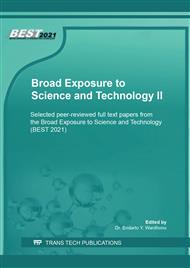[1]
D. Le Corre, J. Bras, A.J.B. Dufresne, Starch nanoparticles: a review, 11 (2010) 1139-1153.
DOI: 10.1021/bm901428y
Google Scholar
[2]
M.M. Abdel-Mottaleb, D. Neumann, A.J.I.j.o.p. Lamprecht, In vitro drug release mechanism from lipid nanocapsules (LNC), 390 (2010) 208-213.
DOI: 10.1016/j.ijpharm.2010.02.001
Google Scholar
[3]
K. Biji, C. Ravishankar, C. Mohan, T.S.J.J.o.f.s. Gopal, technology, Smart packaging systems for food applications: a review, 52 (2015) 6125-6135.
DOI: 10.1007/s13197-015-1766-7
Google Scholar
[4]
A. Caldonazo, S.L. Almeida, A.F. Bonetti, R.E.L. Lazo, M. Mengarda, F.S.J.I.J.o.B.M. Murakami, Pharmaceutical applications of starch nanoparticles: A scoping review, (2021).
DOI: 10.1016/j.ijbiomac.2021.03.061
Google Scholar
[5]
C. Silvestre, D. Duraccio, S.J.P.i.p.s. Cimmino, Food packaging based on polymer nanomaterials, 36 (2011) 1766-1782.
DOI: 10.1016/j.progpolymsci.2011.02.003
Google Scholar
[6]
S.J.W.J.o.S. Tunma, Technology, Starch based nanocomposites in active packaging for extended shelf life of fresh fruits, 15 (2018) 273-281.
DOI: 10.48048/wjst.2018.3849
Google Scholar
[7]
C.C. Villa, L.T. Sanchez, N.D. Rodriguez-Marin, Starch nanoparticles and nanocrystals as bioactive molecule carriers, in: Polymers for agri-food applications, Springer, 2019, pp.91-98.
DOI: 10.1007/978-3-030-19416-1_6
Google Scholar
[8]
P.H. Campelo, A.S. Sant'Ana, M.T.P.S.J.C.O.i.F.S. Clerici, Starch nanoparticles: production methods, structure, and properties for food applications, 33 (2020) 136-140.
Google Scholar
[9]
S. Hedayati, M. Niakousari, Z.J.I.j.o.b.m. Mohsenpour, Production of tapioca starch nanoparticles by nanoprecipitation-sonication treatment, 143 (2020) 136-142.
DOI: 10.1016/j.ijbiomac.2019.12.003
Google Scholar
[10]
H.-Y. Kim, S.S. Park, S.-T.J.C. Lim, S.B. Biointerfaces, Preparation, characterization and utilization of starch nanoparticles, 126 (2015) 607-620.
DOI: 10.1016/j.colsurfb.2014.11.011
Google Scholar
[11]
K. Kraśniewska, S. Galus, M.J.I.j.o.m.s. Gniewosz, Biopolymers-based materials containing silver nanoparticles as active packaging for food applications–A review, 21 (2020) 698.
DOI: 10.3390/ijms21030698
Google Scholar
[12]
D.J. McClements, J.J.C.r.i.f.s. Rao, nutrition, Food-grade nanoemulsions: formulation, fabrication, properties, performance, biological fate, and potential toxicity, 51 (2011) 285-330.
DOI: 10.1080/10408398.2011.559558
Google Scholar
[13]
C. Liu, Y. Qin, X. Li, Q. Sun, L. Xiong, Z.J.I.j.o.b.m. Liu, Preparation and characterization of starch nanoparticles via self-assembly at moderate temperature, 84 (2016) 354-360.
DOI: 10.1016/j.ijbiomac.2015.12.040
Google Scholar
[14]
P.M. Gonçalves, C.P.Z. Noreña, N.P. da Silveira, A. Brandelli, Characterization of starch nanoparticles obtained from Araucaria angustifolia seeds by acid hydrolysis and ultrasound, LWT - Food Science and Technology, 58 (2014) 21-27.
DOI: 10.1016/j.lwt.2014.03.015
Google Scholar
[15]
A. Kasim, Preparation and characterization of sago (metroxylon sp.) Starch nanoparticles using hydrolysis-precipitation method, in: Journal of Physics: Conference Series, IOP Publishing, 2020, p.012021.
DOI: 10.1088/1742-6596/1481/1/012021
Google Scholar
[16]
Y. Qin, C. Liu, S. Jiang, L. Xiong, Q.J.I.C. Sun, Products, Characterization of starch nanoparticles prepared by nanoprecipitation: Influence of amylose content and starch type, 87 (2016) 182-190.
DOI: 10.1016/j.indcrop.2016.04.038
Google Scholar
[17]
S. Agustina, M. Tokuda, H. Minami, C. Boyer, P.B. Zetterlund, Solvent Effects on the Synthesis of Polymeric Nanoparticles via Block Copolymer Self-Assembly Using Microporous Membranes, in: Materials Science Forum, Trans Tech Publ, 2020, pp.324-330.
DOI: 10.4028/www.scientific.net/msf.1000.324
Google Scholar
[18]
S. Agustina, M. Tokuda, H. Minami, C. Boyer, P.B.J.R.C. Zetterlund, Engineering, Synthesis of polymeric nano-objects of various morphologies based on block copolymer self-assembly using microporous membranes, 2 (2017) 451-457.
DOI: 10.1039/c7re00032d
Google Scholar
[19]
F. Hernández-Carmona, Y. Morales-Matos, H. Lambis-Miranda, J.J.J.o.e.c.e. Pasqualino, Starch extraction potential from plantain peel wastes, 5 (2017) 4980-4985.
DOI: 10.1016/j.jece.2017.09.034
Google Scholar
[20]
U. Rodsuwan, U. Pithanthanakul, K. Thisayakorn, D. Uttapap, K. Boonpisuttinant, S. Vatanyoopaisarn, B. Thumthanaruk, V. Rungsardthong, Preparation and characterization of gamma oryzanol loaded zein nanoparticles and its improved stability, 9 (2021) 616-624.
DOI: 10.1002/fsn3.1973
Google Scholar
[21]
Y. Anwar, N.A. Ningtiyas, P.J.C.R.o.B. Simanjuntak, Biotechnology, Isolation of citronellal from Cymbopogon nardus (L) Rendle and its activity test as a burn healing in mice, 2 (2020) 105-108.
DOI: 10.5614/crbb.2020.2.1/nodz4501
Google Scholar


